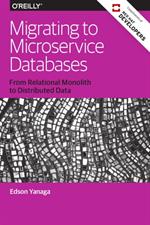Migrating to Microservice Databases
From relational monolith to distributed data

| Вт 24.10.2023 • Sergeant |
| Edson Yanaga |
| 2017 |
| 72 |
| 218 |
After years of researching, coding, and talking about microservices, Edson Yanaga — Red Hat’s Director of Developer Experience — hears one question frequently: how do I evolve my monolithic legacy database? In this practical report, Yanaga explains strategies for dealing with your relational database when migrating from a monolithic codebase to a microservices architecture. In the process, you’ll focus on one key microservices characteristic: decentralized data management.
For many enterprise application developers, microservices are good for splitting up unwieldy codebases into smaller, well-defined, cohesive, and loosely coupled artifacts — an architecture that can simplify and accelerate new software releases. You’ll learn successful strategies for integrating data between your existing monolithic application and your new microservice artifacts.
- Learn how zero downtime migrations enable you to deploy new code without disrupting user activity.
- Evolve your relational database by keeping specific versions of application code and database schemas in the same code repository.
- Understand the distinction behind the CRUD pattern and CQRS — including the consistency models involved in distributed systems.
- Explore a set of nine strategies for integrating data from your monolithic application to a microservice architecture.
 0
0
 0
0
Комментарии
Комментарии: